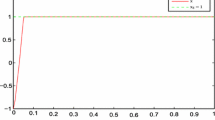Abstract
This paper proposes another adaptive control scheme for nonlinear systems using a Takagi-Sugeno fuzzy model. Takagi-Sugeno fuzzy models have been widely used to identify the structures and parameters of unknown or partially known plants, and to control nonlinear systems. This scheme shows a good approximation capability by the fuzzy blending of local dynamics. Since a Takagi-Sugeno fuzzy model is a nonlinear system in nature, and its parameters are not linearly parameterized, it is difficult to design an adaptive controller using conventional design methods for adaptive controllers which are derived from linearly parameterized systems. In this paper, the functional form of the local dynamics are assumed to be known, but the corresponding parameters are unknown. This additional information about system nonlinearity makes it possible to design an adaptive controller for a nonlinearly parameterized system. The control law is similar to that of a conventional adaptive control technique, while its parameter-update rule is based on the local search method. A parameter-update law is derived so that the time-derivative of the Lyapunov function is negative in the region of interest. Simulation results have shown that this adaptive controller is capable of a good performance.
Similar content being viewed by others
Explore related subjects
Discover the latest articles, news and stories from top researchers in related subjects.References
Lee CC (1990) Fuzzy logic in control systems: fuzzy logic controller. Part I and Part II. IEEE Trans Syst Man Cybern 20:404–435
Takagi T, Sugeno M (1985) Fuzzy identification of systems and its applications to modeling and control. IEEE Trans Syst Man Cybern 15:116–132
Bezdek JC (1993) Editorial: fuzzy models—what are they and why? IEEE Trans Fuzzy Syst 1:1–6
Kim E, Park M, Ji S, et al. (1997) A new approach to fuzzy modeling. IEEE Trans Fuzzy Syst 5:328–337
Joh J, Chen Y, Langari R (1998) On the stability issues of linear Takagi-Sugeno fuzzy models, IEEE Trans Fuzzy Syst 6:402–410
Wang L (1998) Stable and optimal fuzzy control of linear systems. IEEE Trans Fuzzy Syst 6:137–143
Maeda M, Murakami S (1992) A self-tuning fuzzy controller. Fuzzy Sets Syst 51:29–40
Ting CS, Li THS, Kung FC (1996) An approach to systematic design of a fuzzy control system. Fuzzy Sets Syst 77:151–166
Wang L-X (1997) Stable adaptive fuzzy control of nonlinear systems. IEEE Trans Fuzzy Syst 1:146–155
Azam F, VanLandingham HF (1998) A generalized fuzzy adaptive control method. IEEE International Conference on Systems, Man and Cybernetics, IEEE, SanDiego, pp 2083–2088
Wang L-X (1993) A course in fuzzy systems and control. Prentice-Hall, Englewood Cliffs
Annaswamy AM, Skantze FP, Loh A-P (1998) Adaptive control of continuous time systems with convex/concave parameterization. Automatica 34:33–49
Author information
Authors and Affiliations
Corresponding author
About this article
Cite this article
Lee, CY., Eom, TD. & Lee, JJ. Stable nonlinear controller design for a Takagi-Sugeno fuzzy model. Artif Life Robotics 5, 20–25 (2001). https://doi.org/10.1007/BF02481316
Received:
Accepted:
Issue Date:
DOI: https://doi.org/10.1007/BF02481316




